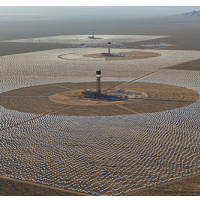Pilots Say Glare from Newly-Opened Ivanpah Solar Farm Is Blindingly Dangerous
 Ivanpah Solar Electric Generating System (photo: BrightSource Energy)
Ivanpah Solar Electric Generating System (photo: BrightSource Energy)
A pilot flying over the newly-completed Ivanpah Solar Electric Generating System in the Mojave Desert, near the Nevada border, complained to the Federal Aviation Administration (FAA) that he was “nearly blinded” by reflections from the huge mirrors used to harness the sun’s rays.
He is apparently not alone, according to federal documents reviewed by the Riverside Press-Enterprise. An anonymous Los Angeles air traffic controller told the FAA that pilots had complained to him about the blinding light and that he himself had experienced it as a passenger flying over. “I have no idea what can be done about this situation, but being a passenger on an aircraft that flew through this airspace and saw it for myself, I would say that something needs to be done. It is extremely bright and distracting,” the controller wrote.
The complaints were reportedly made to the Aviation Safety Reporting System (ASRS) last August, relayed to the FAA in November, passed along to Nevada’s Clark County Department of Aviation in January and sent to NRG Energy and Bright Source Energy, co-owners and operators of the plant, last week.
The companies were asked to respond within 10 days to the ASRS, the California Energy Commission (CEC) and the U.S. Bureau of Land Management (BLM). Ivanpah sits on public land leased from the BLM.
Ivanpah is reputed to be the world’s largest solar energy project in the world, with 170,000 heliostat mirrors focusing the sun’s rays on 459-foot-high tanks of water, producing steam to run a conventional turbine that produces electricity. It began producing electricity last year and came online in December.
The $2.2-billion project, which is designed to provide power for 140,000 homes, is 50 miles from McCarran International Airport in Las Vegas. It is only 23 miles from Jean Sport Aviation Center and closer to where Nevada wants to build another airport. Pilots would be particularly susceptible to glare during takeoffs and landings, which can cause flash blindness (pdf) for four to 12 seconds.
Ivanpah was the subject of lengthy battles over environmental issues, as conservationists sought to protect fragile native habitats and endangered animals. Large-scale projects like Ivanpah were once the focal point of solar’s future. That is changing. While solar is still a hot commodity, especially in California where state law compels utilities to get a third of their energy from renewable sources by 2020, there has been a decided shift from large projects to mid-size and small ones.
Problems with reflection (pdf) from massive solar farms are not unknown and were anticipated during the planning of Ivanpah.
A January 2009 letter (pdf) from the McCarran Airport planning manager to the California Energy Commission warned the glare could be a problem at Jean Sport and the proposed Southern Nevada Supplemental Airport (SNDA). Arnold sent the commission a report by ASRC Research and Technology Solutions (ARTS) that said, “Glare from the heliostat mirrors could be a significant hazard to air navigation.”
“It should be noted that Sandia National Laboratories, the organization responsible for Solar One and Solar Two, does not believe it will be bright enough to affect air traffic,” the report noted. “It should also be noted they have not indicated that they have done any aircraft testing near the facility.”
–Ken Broder
To Learn More:
Pilots Complain of Solar Plant Glare (by Janet Zimmerman, Riverside Press-Enterprise)
Ivanpah Solar Plant Opens near California-Nevada Border (by Brian Skoloff and Michael R. Blood, Associated Press)
Hazard Analyses of Glint and Glare from Concentrating Solar Power Plants (by Clifford K. Ho, Cheryl M. Ghanbari and Richard B. Diver, Sandia National Laboratories) (pdf)
Are Large Solar Projects in California Running out of Steam? (by Ken Broder, AllGov California)
Solar Farm Projects Near Airports: Is Glare an Issue? (by James Martin II, Solar Choice)
- Top Stories
- Controversies
- Where is the Money Going?
- California and the Nation
- Appointments and Resignations
- Unusual News
- Latest News
- California Forbids U.S. Immigration Agents from Pretending to be Police
- California Lawmakers Urged to Strip “Self-Dealing” Tax Board of Its Duties
- Big Oil’s Grip on California
- Santa Cruz Police See Homeland Security Betrayal in Use of Gang Roundup as Cover for Immigration Raid
- Oil Companies Face Deadline to Stop Polluting California Groundwater





